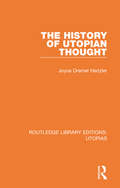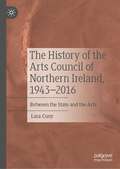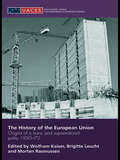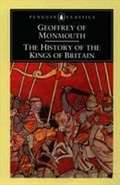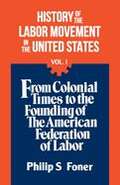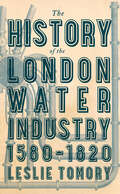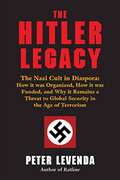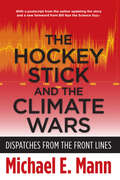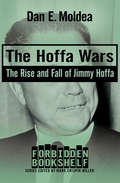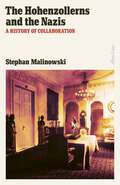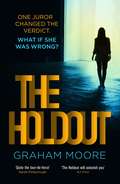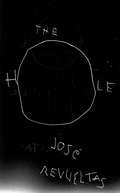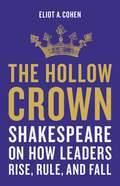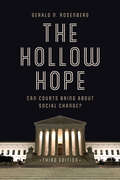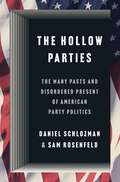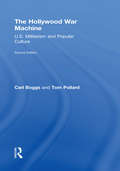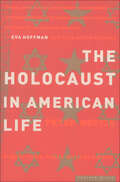- Table View
- List View
The History of Utopian Thought (Routledge Library Editions: Utopias)
by Joyce Oramel HertzlerThis book, originally published in 1923, embodies two related and yet distinct types of sociological endeavour. It is a study in the history of social thought, a field which had only been receiving serious and widespread attention in recent years, and attempts to give an historical cross-section of representative Utopian thought at the time. But it is also a study in social idealism, a study in the origin, selection and potency of those social ideas and ideals that occasional and usually exceptional men conceive, with particular emphasis upon their relation to social progress. It was the first book that attempted to give an unprejudiced, systematic treatment of the social Utopias as a whole.
The History of the Arthaśāstra: Sovereignty and Sacred Law in Ancient India (Ideas in Context #120)
by Mark McClishThe Arthaśāstra is the foundational text of Indic political thought and ancient India's most important treatise on statecraft and governance. It is traditionally believed that politics in ancient India was ruled by religion; that kings strove to fulfil their sacred duty; and that sovereignty was circumscribed by the sacred law of dharma. Mark McClish's systematic and thorough evaluation of the Arthaśāstra's early history shows that these ideas only came to prominence in the statecraft tradition late in the classical period. With a thorough chronological exploration, he demonstrates that the text originally espoused a political philosophy characterized by empiricism and pragmatism, ignoring the mandate of dharma altogether. The political theology of dharma was incorporated when the text was redacted in the late classical period, which obscured the existence of an independent political tradition in ancient India altogether and reinforced the erroneous notion that ancient India was ruled by religion, not politics.
The History of the Arts Council of Northern Ireland, 1943–2016: Between the State and the Arts
by Lara CunyThis book presents the history of the Council for the Encouragement of Music and the Arts (CEMA) in Northern Ireland from its conception in 1943, and its successor organisation, the Arts Council of Northern Ireland (ACNI). Exploring the political and social impact of cultural policy in Northern Ireland, the book illustrates how the arts developed during the twentieth century and sheds light on the relationship between politics and culture. The author takes a closer look at the responsibilities of ACNI, and examines its interaction with the unionist government, which sought to influence how the organisation distributed its grants. Spanning the outbreak of the Troubles in the 1960s and the Peace Process in the 1990s, the ACNI evolved through a period of conflict and change, and therefore this book argues that there was an undeniable link between the changing political environment and the management of the arts in Northern Ireland. The arm’s length principle is analysed in relation to ACNI, examining the influence that the state had upon its management and governance. Offering a unique historical overview of the arts in Northern Ireland, this interdisciplinary book fills a gap in Irish history and presents insights into cultural policy, conflict resolution and political history.
The History of the East Sea and the Sea of Japan: Origin of Geographical Names, Conflicts and Solutions (Historical Geography and Geosciences)
by Jeongbo ShimThis monograph discusses the dispute in geographical naming of the sea between Korea and Japan, which has been a long-lasting issue in East Asia and beyond. The book covers the modern history of the dispute, reveals the origin of the names for the sea between Korea and Japan, and the historical change of the name on ancient maps of Korea, Japan, and the West, and tracks the naming trends of the East Sea in geography textbooks in the pre-modern and modern times. The book also contains suggestions for some tangible solutions for the issue. This book is a useful resource for students and scholars in the fields of political geography, historical geography, cartography, diplomatic history, international relations, politics, and other related disciplines. It also appeals to international experts in hydrographic organizations and the United Nations, and geography and history teachers. The book is also interesting for the general readers interested in the topic of geographical naming disputes.
The History of the European Union: Origins of a Trans- and Supranational Polity 1950-72 (Routledge/UACES Contemporary European Studies #Vol. 7)
by Wolfram Kaiser Brigitte Leucht Morten RasmussenThis book radically re-conceptualises the origins of the European Union as a trans- and supranational polity as it emerged between the Schuman Plan of May 1950 and the first enlargement of the European Communities at the start of 1973. Drawing upon social science theories and debates as well as recent historical research, Wolfram Kaiser and Morten Rasmussen in their introductory chapters discuss innovative ways of narrating the history of the EU as the emergence of a transnational political society and supranational political system. Building on these insights, eight chapters based on multilateral and multi-archival research follow each with case studies of transnational networks, public sphere and institutional cultures and policy-making which illustrate systematically related aspects of the early history of the EU. In the concluding chapter, leading political scientist Alex Warleigh-Lack demonstrates how greater interdisciplinary cooperation, especially between contemporary history and political studies, can significantly advance our knowledge of the EU as a complex polity. This book will be of interest to students and scholars of Politics, European Studies and History.
The History of the Idea of Europe
by Kevin Wilson Jan Van DussenThe History of the Idea of Europe by Kevin Wilson and Jan Van Dussen.
The History of the Kings of Britain
by Geoffrey Of MonmouthCompleted in 1136, The History of the Kings of Britain traces the story of the realm from its supposed foundation by Brutus to the coming of the Saxons some two thousand years later. Vividly portraying legendary and semi-legendary figures such as Lear, Cymbeline, Merlin the magician and the most famous of all British heroes, King Arthur, it is as much myth as it is history and its veracity was questioned by other medieval writers. But Geoffrey of Monmouth's powerful evocation of illustrious men and deeds captured the imagination of subsequent generations, and his influence can be traced through the works of Malory, Shakespeare, Dryden and Tennyson. Translated and with an introduction by Lewis Thorpe.
The History of the Labor Movement in the United States, Vol. 1: From Colonial Times to the Founding of the American Federation of Labor
by Philip S. FonerTextbook on: Early trade unions and labor parties; The 10-hour movement; Northern labor and slavery; Labor and the Civil War; Rise of the Knights of Labor; Depression 1873-78 and strikes; Labor political action, and more.
The History of the London Water Industry, 1580–1820
by Leslie TomoryThis in-depth study explores the technological, cultural, and mercantile factors behind the infrastructure that transformed early modern London.Beginning in 1580, a number of competing London companies sold water directly to consumers through a large network of wooden mains in the expanding metropolis. This new water industry flourished throughout the 1600s, eventually expanding to serve tens of thousands of homes. By the late eighteenth century, more than 80 percent of the city’s houses had water connections—making London the best-served metropolis in the world while demonstrating that it was legally, commercially, and technologically possible to run an infrastructure network within the largest city on earth.Historian Leslie Tomory shows how an explosion of consumer demand and new technologies imported from the Continent spurred the rapid growth of London’s water industry. Meanwhile, several key local innovations reshaped the industry by enlarging the size of the supply network. By 1800, the success of London’s water industry made it a model for cities across Europe and beyond. It even inspired builders of other large-scale urban projects, including gas and sewage supply networks.
The History of the Stasi: East Germany's Secret Police, 1945-1990
by Jens GiesekeThe East German Ministry for State Security stood for Stalinist oppression and all-encompassing surveillance. The "shield and sword of the party," it secured the rule of the Communist Party for more than forty years, and by the 1980s it had become the largest secret-police apparatus in the world, per capita. Jens Gieseke tells the story of the Stasi, a feared secret-police force and a highly professional intelligence service. He inquires into the mechanisms of dictatorship and the day-to-day effects of surveillance and suspicion. Masterful and thorough at once, he takes the reader through this dark chapter of German postwar history, supplying key information on perpetrators, informers, and victims. In an assessment of post-communist memory politics, he critically discusses the consequences of opening the files and the outcomes of the Stasi debate in reunified Germany. A major guide for research on communist secret-police forces, this book is considered the standard reference work on the Stasi and has already been translated into a number of Eastern European languages.
The Hitler Bloodline: Uncovering the Führer's Secret Family
by David GardnerThe Hitler Family Then and NowJoin author David Gardner as he traces the genealogy of history’s most notorious dictator in this revelatory World War 2 biographyA family history haunted by a sinister past. The name Hitler is remembered around the world as the Nazi leader responsible for the deadliest war in modern history. But what about those who share the same last name? Who was the Hitler family, and where are they now? Crime journalist David Gardner investigates these questions in The Hitler Bloodline, a family tree book into how Adolf Hitler shaped the lives and legacy of his siblings and their descendants.Over a century of stories to share. Discover a new side of history with what family life was like before and after the Fuehrer. Starting long before a young Hitler came into the picture, get to know the parents and the older siblings who grew up with the most notorious man in European history. And with the personal accounts of extended family members during and after World War 2, The Hitler Bloodline shares what it was like for the surviving descendants to break away from their family’s darkest shadow. With new details and surprising revelations in David Gardner’s historical research, learn how generations of a family can be impacted by the legacy of their surname to this very day.Inside, you’ll also find:A genogram of past and present household membersHow Hitler’s nephew joined the United States NavyIf the Hitler family has Jewish ancestryThe identity of an alleged sonIf you liked World War 2 biographies such as Fatherland, The Splendid and the Vile, or The Best New True Crime Stories: Crimes of Famous & Infamous Criminals, you’ll love The Hitler Bloodline.
The Hitler Legacy: The Nazi Cult In Diaspora: How It Was Organized, How It Was Funded, And Why It Remains A Threat To Global Security In The Age Of Terrorism
by Peter LevendaMore than thirty years after his first investigation of the Nazi underground Peter Levenda has returned again and again to his quest for the truth about the true character of the Nazi cult and the people and political movements it has influenced in the decades since the end of World War II. The wide sweep of this investigation moves from a Ku Klux Klan headquarters in Reading, Pennsylvania to the New York City office of the Palestine Liberation Organization; from the apartment of a notorious neo-Nazi leader to an Islamic boarding school—headquarters of the man who ordered the Bali Bombings. When Levenda uncovered the existence of a Nazi underworld in Asia, the nexus of religion, politics, terrorism and occult beliefs was revealed to be the real domain of the threat to global security. Meticulously researched—from both archival material and declassified intelligence agency files, to personal interviews and investigations undertaken in Asia, Europe and Latin America—The Hitler Legacy is the story of how the mistakes of the 20th century have come home to roost in the 21st. This book will challenge the conventional thinking about such subjects as the Muslim Brotherhood and Islamist terrorism and even about the alleged death of one of history's most infamous killers—Adolf Hitler.
The Hockey Stick and the Climate Wars
by Michael E. MannThe ongoing assault on climate science in the United States has never been more aggressive, more blatant, or more widely publicized than in the case of the Hockey Stick graph-a clear and compelling visual presentation of scientific data, put together by MichaelE. Mann and his colleagues, demonstrating that global temperatures have risen in conjunction with the increase in industrialization and the use of fossil fuels. Here was an easy-to-understand graph that, in a glance, posed a threat to major corporate energy interests and those who do their political bidding. The stakes were simply too high to ignore the Hockey Stick-and so began a relentless attack on a body of science and on the investigators whose work formed its scientific basis.The Hockey Stick achieved prominence in a 2001 UN report on climate change and quickly became a central icon in the "climate wars." The real issue has never been the graph's data but rather its implied threat to those who oppose governmental regulation and other restraints to protect the environment and planet. Mann, lead author of the original paper in which the Hockey Stick first appeared, shares the story of the science and politics behind this controversy. He reveals key figures in the oil and energy industries and the media frontgroups who do their bidding in sometimes slick, sometimes bare-knuckled ways. Mann concludes with the real story of the 2009 "Climategate" scandal, in which climate scientists' emails were hacked. This is essential reading for all who care about our planet's health andour own well-being.
The Hockey Stick and the Climate Wars: Dispatches from the Front Lines
by Michael MannThe ongoing assault on climate science in the United States has never been more aggressive, more blatant, or more widely publicized than in the case of the Hockey Stick graph—a clear and compelling visual presentation of scientific data, put together by MichaelE. Mann and his colleagues, demonstrating that global temperatures have risen in conjunction with the increase in industrialization and the use of fossil fuels. Here was an easy-to-understand graph that, in a glance, posed a threat to major corporate energy interests and those who do their political bidding. The stakes were simply too high to ignore the Hockey Stick—and so began a relentless attack on a body of science and on the investigators whose work formed its scientific basis.The Hockey Stick achieved prominence in a 2001 UN report on climate change and quickly became a central icon in the "climate wars." The real issue has never been the graph's data but rather its implied threat to those who oppose governmental regulation and other restraints to protect the environment and planet. Mann, lead author of the original paper in which the Hockey Stick first appeared, shares the story of the science and politics behind this controversy. He reveals key figures in the oil and energy industries and the media frontgroups who do their bidding in sometimes slick, sometimes bare-knuckled ways. Mann concludes with the real story of the 2009 "Climategate" scandal, in which climate scientists' emails were hacked. This is essential reading for all who care about our planet's health and our own well-being.
The Hoffa Wars: The Rise and Fall of Jimmy Hoffa (Forbidden Bookshelf #12)
by Dan E. MoldeaThe definitive portrait of the powerful, corruption-ridden Teamsters union and its legendary president, Jimmy Hoffa—organizer, gangster, convict, and conspirator—with a new afterword by the author James Riddle &“Jimmy&” Hoffa was one of the most fascinating and controversial figures in twentieth-century America. His remarkable journey from young union organizer to all-powerful head of the International Brotherhood of Teamsters is an epic tale worthy of a Hollywood blockbuster, jam-packed with intrigue, subterfuge, violence, and corruption. His successes were monumental, his fall truly spectacular, and his bizarre disappearance in the summer of 1975 remains one of the great mysteries in American history. Widely considered to be the definitive volume on the career and crimes of Jimmy Hoffa, The Hoffa Wars, by acclaimed investigative journalist Dan E. Moldea, is an eye-opening, extensively researched account of the steady rise and fall of an ingenious, ambitious man who was instrumental in transforming a small union of seventy-five thousand truckers into the most powerful labor brotherhood in world. Shocking disclosures in Moldea&’s no-holds-barred account include the devil&’s bargain that put Hoffa and his union in the pockets of the Mob, Hoffa&’s role in the joint CIA-Mafia plots to kill Cuban leader Fidel Castro, the deal Hoffa made with US president Richard Nixon that released the disgraced Teamster president from prison eight years early, and the truth behind Hoffa&’s eventual disappearance and likely murder. But perhaps the most startling revelation of all concerns the integral part Jimmy Hoffa played, in concert with underworld kingpins Carlos Marcello and Santos Trafficante, in America&’s most terrible twentieth-century crime: the assassination of President John F. Kennedy.
The Hohenzollerns and the Nazis: A History of Collaboration
by Stephan MalinowskiThe shocking true story of the German monarchy's collaboration with the Nazis - already a bestseller in Germany, now in English for the first time.**AWARDED THE GERMAN NON-FICTION PRIZE 2022**'Malinowksi’s work is a near-masterpiece, relating a story not synthesised in this way before, and about which any number of self-serving myths exist' - Simon Heffer, The Telegraph‘Stephan Malinowski's brilliant book strikes a balance between the forensic analysis of individual behaviour and a new understanding of how the toxic political culture of a defeated monarchy helped to disrupt democracy in Germany' - Christopher ClarkThe disappearance of the Hohenzollern family from the history of Germany in November 1918 as the Kaiser fled into Dutch exile is one of the most startling, rapid instances of a once all-powerful royal family becoming almost overnight irrelevant and marginal. Except this is not exactly what happened.Stephan Malinowski’s German bestseller is an extraordinary work of recovery. It suited both the Weimar Republic and then the Third Reich to view the Hohenzollerns with contempt, and yet the royal family’s hatred of the former and approval of the latter were for millions of Germans a significant factor in their own view of their country and its government.With forensic and often shocking detail, Malinowski shows that, far from being ridiculous, marginal figures the Hohenzollerns lay at the heart of Germany’s ongoing nightmare. Despite formally losing power, the members of the royal family remained prominent, catastrophically allowing many other conservative Germans to stay distanced from the new republic and to eventually betray conservative traditions and values. Battered from both left and right, the Republic collapsed in 1933 in part because conservative forces, fearful of both Communism and Fascism, had abandoned their own principles just as much as the leading members of former royal family had, who were themselves beguiled by and fooled by Hitler.This is an important and shocking book, as well as a devastating picture of an inadequate and trivial royal family painfully underequipped to fulfil its role.
The Holdout: The tense, gripping Richard and Judy Book Club pick for 2021
by Graham Moore'The most gripping and satisfying thriller I've read in more than a decade' Sophie Hannah'One of the best legal thrillers ... as elegant and gripping as Scott Turow's Presumed Innocent' Daily Mail'Quite the tour de force! Twelve Angry Men meets Chinatown and creates something of its own' Sarah Pinborough'This is a tense, emotionally charged, scary-good, stand-out read' Caroline Kepnes**********MAJOR TV SERIES COMING SOON - FROM THE PEOPLE WHO BROUGHT YOU NETFLIX'S UNBELIEVABLE... One juror changed the verdict. What if she was wrong?'Ten years ago we made a decision together...'Fifteen-year-old Jessica Silver, heiress to a billion-dollar fortune, vanishes on her way home from school. Her teacher, Bobby Nock, is the prime suspect. It's an open and shut case for the prosecution, and a quick conviction seems all but guaranteed. Until Maya Seale, a young woman on the jury, persuades the rest of the jurors to vote not guilty: a controversial decision that will change all of their lives forever.Ten years later, one of the jurors is found dead, and Maya is the prime suspect.The real killer could be any of the other ten jurors. Is Maya being forced to pay the price for her decision all those years ago?**********'Plunge a syringe filled with adrenaline into the heart of Twelve Angry Men and you've got The Holdout: the first legal thriller in thirty years - ever since Presumed Innocent and A Time to Kill electrified readers the world over - to rank alongside those two modern classics.' AJ Finn'A page-turning legal thriller with a twisty and absolutely riveting plot ... plus a strong and compelling female heroine. You won't be able to put this one down!' Lisa Scottoline'Clever, well-written and twistier than a can of silly-string. You absolutely need to read The Holdout!' Emma Kavanagh'Amazing thriller, deserves to be one of the biggest books of 2020' Michelle Davies'Terrific, twisty and well-structured thriller' Adele Geras
The Hole
by Álvaro Enrigue José RevueltasA classic of Mexican literature in the twentieth century, The Hole is a dazzlingly devastating novella A classic of Mexican literature in the twentieth century, The Hole is a dazzlingly devastating novella A classic of Mexican literature in the twentieth century, The Hole is a dazzlingly devastating novella Set in a Mexican prison in the late 1960s, The Hole follows three inmates as they plot to sneak in drugs under the noses of their ape-like guards. The inmates desperately need to secure their next fix, and hatch a plan that involves convincing one of their mothers to bring the drugs into the prison, inside her person. But everything about their plan is doomed from the beginning, doomed to end in violence… Unfolding in a single paragraph, The Hole is a verbal torrent, a prison inside a prison, and an ominous parable about how deformed and wretched institutions create even more deformed and wretched individuals.
The Hollow Crown: Shakespeare on How Leaders Rise, Rule, and Fall
by Eliot A. CohenWhat Shakespeare&’s plays can teach us about modern-day politics William Shakespeare understood power: what it is, how it works, how it is gained, and how it is lost. In The Hollow Crown, Eliot A. Cohen reveals how the battling princes of Henry IV and scheming senators of Julius Caesar can teach us to better understand power and politics today. The White House, after all, is a court—with intrigue and conflict rivaling those on the Globe&’s stage—as is an army, a business, or a university. And each court is full of driven characters, in all their ambition, cruelty, and humanity. Henry V&’s inspiring speeches reframe John F. Kennedy&’s appeal, Richard III&’s wantonness illuminates Vladimir Putin&’s brutality, and The Tempest&’s grace offers a window into the presidency of George Washington. An original and incisive perspective, The Hollow Crown shows how Shakespeare&’s works transform our understanding of the leaders who, for good or ill, make and rule our world.
The Hollow Hope: Can Courts Bring About Social Change? (2nd edition)
by Gerald N. RosenbergIn follow-up studies, dozens of reviews, and even a book of essays evaluating his conclusions, Gerald Rosenberg's critics-- not to mention his supporters-- have spent nearly two decades debating the arguments he first put forward in The Hollow Hope. With this substantially expanded second edition of his landmark work, Rosenberg himself steps back into the fray, responding to criticism and adding chapters on the same-sex marriage battle that ask anew whether courts can spur political and social reform. Finding that the answer is still a resounding no, Rosenberg reaffirms his powerful contention that it's nearly impossible to generate significant reforms through litigation. The reason? American courts are ineffective and relatively weak-- far from the uniquely powerful sources for change they're often portrayed as. Rosenberg supports this claim by documenting the direct and secondary effects of key court decisions-- particularly Brown v. Board of Education and Roe v. Wade. He reveals, for example, that Congress, the White House, and a determined civil rights movement did far more than Brown to advance desegregation, while pro-choice activists invested too much in the expense of political mobilization. Further illuminating these cases, as well as the on going fight for same-sex marriage rights, Rosenberg also marshals impressive evidence to overturn the common assumption that even unsuccessful litigation can advance a cause by raising its profile. Directly addressing its critics in a new conclusion, The Hollow Hope, Second Edition promises to reignite for a new generation the national debate it sparked seventeen years ago.
The Hollow Hope: Can Courts Bring About Social Change? (American Politics And Political Economy Ser.)
by Gerald N. RosenbergPresents a powerful argument for the limitations of judicial action to support significant social reform—now updated with new data and analysis. Since its first publication in 1991, The Hollow Hope has spurred debate and challenged assumptions on both the left and the right about the ability of courts to bring about durable political and social change. What Gerald N. Rosenberg argued then, and what he confirms today through new evidence in this edition, is that it is nearly impossible to generate significant reforms through litigation: American courts are ineffective and relatively weak, far from the uniquely powerful sources for change they are often portrayed to be. This third edition includes new data and a substantially updated analysis of civil rights, abortion rights and access, women’s rights, and marriage equality. Addressing changes in the political and social environment, Rosenberg draws lessons from the re-segregation of public schools, victories in marriage equality, and new obstacles to abortion access. Through these and other cases, the third edition confirms the power of the book’s original explanatory framework and deepens our understanding of the limits of judicial action in support of social reform, as well as the conditions under which courts do produce change. Up-to-date, thorough, and thought-provoking, The Hollow Hope remains vital reading.
The Hollow Parties: The Many Pasts and Disordered Present of American Party Politics (Princeton Studies in American Politics: Historical, International, and Comparative Perspectives #202)
by Daniel Schlozman Sam RosenfeldA major history of America's political parties from the Founding to our embittered presentAmerica&’s political parties are hollow shells of what they could be, locked in a polarized struggle for power and unrooted as civic organizations. The Hollow Parties takes readers from the rise of mass party politics in the Jacksonian era through the years of Barack Obama and Donald Trump. Today&’s parties, at once overbearing and ineffectual, have emerged from the interplay of multiple party traditions that reach back to the Founding.Daniel Schlozman and Sam Rosenfeld paint unforgettable portraits of figures such as Martin Van Buren, whose pioneering Democrats invented the machinery of the mass political party, and Abraham Lincoln and other heroic Republicans of that party&’s first generation who stood up to the Slave Power. And they show how today&’s fractious party politics arose from the ashes of the New Deal order in the 1970s. Activists in the wake of the 1968 Democratic National Convention transformed presidential nominations but failed to lay the foundations for robust, movement-driven parties. Instead, modern American conservatism hollowed out the party system, deeming it a mere instrument for power.Party hollowness lies at the heart of our democratic discontents. With historical sweep and political acuity, The Hollow Parties offers powerful answers to pressing questions about how the nation&’s parties became so dysfunctional—and how they might yet realize their promise.
The Hollywood Kid: The Violent Life and Violent Death of an MS-13 Hitman
by Oscar Martinez Juan MartinezThe compelling story of the life and death of a Salvadoran gangsterAs a boy, Miguel Ángel Tobar’s small town in El Salvador was torn apart by guerrillas and US- backed death squads. Still a preteen, he joined a different kind of death squad—the Hollywood Locos Salvatrucha—a clique of the Mara Salvatruchas, better known as MS-13. This international criminal organization began on the streets of Los Angeles in the 1980s, as Salvadoran children, whose families had fled their country’s civil war, banded together to defend themselves from LA gangs. Denied refugee status, the Salvadorans found themselves pushed into the shadows and besieged by violence, and MS-13 itself mutated into a gang. When large-scale US deportations began, violence was exported from the United States to El Salvador, helping make it one of the world’s deadliest countries and in turn propelling new waves of refugees northward. The Salvadoran journalist Óscar Martinez and his anthropologist brother Juan José Martínez got to know the Hollywood Kid when he informed on MS-13. In his hideaway shack, he recounted a life of killing—a death toll of more than fifty rival gang members—until his own murder ended the story. Vivid and violent, The Hollywood Kid brings a brutal world to life, illustrating the geopolitical forces propelling a country toward ever more vicious extremes.
The Hollywood War Machine: U.S. Militarism and Popular Culture
by Carl BoggsThe newly expanded and revised edition of The Hollywood War Machine includes wide-ranging exploration of numerous popular military-themed films that have appeared in the close to a decade since the first edition was published. Within the Hollywood movie community, there has not been even the slightest decline in well-financed pictures focusing on warfare and closely-related motifs. The second edition includes a new chapter on recent popular films and another that analyzes the relationship between these movies and the bourgeoning gun culture in the United States, marked in recent years by a dramatic increase in episodes of mass killings.
The Holocaust In American Life
by Peter NovickThis “courageous and thought-provoking book” examines how the Holocaust came to hold its unique place in American memory (Foreign Affairs).Prize–winning historian Peter Novick explores in absorbing detail the decisions that moved the Holocaust to the center of American life. He illuminates how Jewish leaders invoked its memory to muster support for Israel, and how politicians in turn used it to score points with Jewish voters. With insight and sensitivity, Novick raises searching questions about these developments, their meaning, and their consequences. Does the Holocaust really teach useful lessons and sensitize us to atrocities, or, by making the Holocaust the measure, does it make lesser crimes seem “not so bad”? Have American Jews, by making the Holocaust the emblematic Jewish experience, given Hitler a posthumous victory, tacitly endorsing his definition of Jews as despised pariahs? What are we to make of the fact that while Americans spend hundreds of millions of dollars for museums recording a European crime, while comparatively little is done to memorialize American slavery?A New York Times Notable Book
